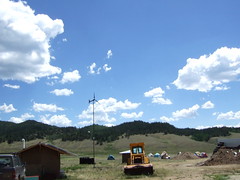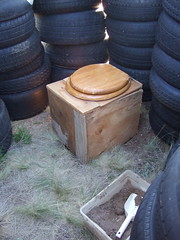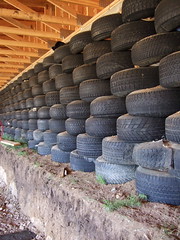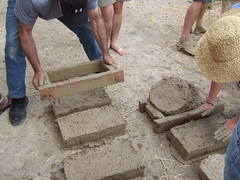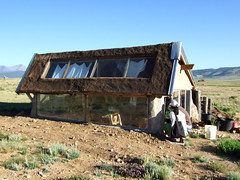Off The Grid In Colorado
My quest to seek a sustainable living example in the States takes me to the outbacks of Colorado.
Wild West Tamed
When Thai people think of America they see cowboys and Indians streaming down a mountain range onto a wide, open space devoid of modern settlements. As we drove through the Kenosha pass from Denver into a grassland basin known as a park (yes, as in South Park), I, too, envisioned the old West. Looking at the few old wooden buildings dotting the landscape here and there, I absorbed a timelessness and an isolation that could render one forgetful of an outside world or the changes wrought therein.
I was accompanied by three Thais and an American woman who ran an NGO in Nepal. We were headed for a five-day building workshop in the tiny outpost of Jefferson, Colorado. Our hosts were two schoolteachers, Kip and Kristen. Kristen's sister Peggy was married to Jo, the founder of the Thai adobe building movement. Their brother Nate, I had met already on the tour of sustainable Thailand that I had joined earlier this year.
Over the three-hour drive Peggy was filling me in on how she happened to end up making a life in Thailand beginning with a pivotal student year abroad there. Now her family had convened to build a Thai style family compound on 44 acres of land they had bought together here in Jefferson. Upon our arrival at the end of a dirt road, we jumped out to admire the chocolate brown straw bale house with its steep snow-shedding metal roof. Inside the two-bedroom house, was a modern kitchen (no dishwasher) and a full bathroom.
The house was off the grid, powered by 1.5 kilowatts of solar panels and 12 deep cycle batteries with a propane generator back up. The solar panels sat on the low roof of the battery hut. After a winter of high propane use, they had installed a wood burning stove to augment the radiant floor heating in the house. A windmill near the battery hut also generated energy. Kip had built the hut from leftovers from the big house covered with cob (a mix of mud and straw). It had wet his appetite for building with natural materials. The strawbale house had been constructed for their parents with the help of professionals and still maintained aspects of conventional building, but that's where the familiar ended.
Pit Toilet
We were introduced to our own camp toilet. Jo had fashioned it from stacks of old tires creating walls around the pit toilet he had dug. A bottomless plywood box covering the hole was outfitted with a wooden toilet seat. I made note of the simplicity of this emergency style toilet which was sturdier and more comfortable than the five gallon bucket and cheap toilet seat sold online, inside of which would be packed your earthquake supplies. In three days, 18 people would fill the two and a half foot deep hole and Jo would dig another one nearby and move the tire walls. Later the family would plant a tree where the pit had been. It didn't smell or attract flies because we covered our deposits with sand. I was pleased to note that everyone seemed happy to use this makeshift toilet even the Thais.
That I was having to come to the American West to meet Thai people interested in alternative living and natural building filled me with a sense of the irony of our globalized life. Dee had remained in Seattle after college when he bought and ran his own restaurant for many years. He had sold it in preparation to return to Thailand. His girlfriend Jui's had a vision to build a green resort and spa. Jui's sister, Jick, rounded out the threesome. Jui worked for the airlines thus the family was very well traveled. It was the sisters who had been interested in Jo's work, having seen him on a Thai television show called Philosophers Who Walk The Earth. Their father had also been a building maverick using earth to build their home.
The three had greeted me with the traditional Thai greeting, the wai, and I introduced myself by my Thai name, Noo. They immediately attached the honorific appropriate to my seniority and thus I was addressed by a name filled with affectionate family connotations—Elder Rat.
In the sage covered field of this American cowboy country, we pitched our tents, kicking up the smell of lavender as we walked. Every day puffy white cumulus clouds in an intensely blue sky would go a long way to wiping the apocalyptic vision of smoke charred skies we in the Bay Area had been enduring through a summer of fires. I found the act of building comforted me when all else seemed beyond my control. To be in community with others seeking to lighten their eco footprint completed the healing. We had two masseuse, a yoga teacher, a glass blower, a self described unlicensed vagabond, an au-pair living in Paris, a college Freshman and a pair of systems engineers. Only four men, not counting the three who were our hosts.
Earthship Home
We would be helping to build a home for Kip and Kristen-a fair size three-bedroom earthship. The earthship being the invention of Americans in New Mexico who had put to use discarded automobile tires and aluminum cans in their passive solar buildings. As teachers, Kip and Kristen had plenty of time off in the summer and schoolteachers' salaries, thus the choice of the earthship. Tires were free including delivery and assembly, though arduous, required non-skilled labor; each tire was stacked and filled with earth, then packed tight by pounding with sledgehammers. It took them most of last summer to assemble the wall of 850 tires.
Inside the unfinished shell of the earthship it was dramatically cooler given the 100° temperatures that first day. The tire wall, which extended the length of the back wall, had been covered on the outside with earth sloping down to the ground. This created the thermal conditions of a cave. The front wall was all windows, traditionally framed in wood, sheathed with oriented strand board and insulated with Styrofoam. Within this shell we would build adobe walls to partition off the pantry and mudroom.
Brick making in the Western world is scientific—you test the soil, establish a recipe, take notes and generally control everything, but Jo preferred the easy Thai way. He just looked at how the ground cracked where it had been soaked. He picked up a handful and squeezed it in his hand and played with it. If it's sticky it's good, he told us. He flooded a shallow pit with water because as you pull in more earth and sand, the rocks fall to the bottom since they are heavier. This saves having to sift the soil though our feet would still find the rocks. Just as with cob building, we mixed the straw into the mud with our feet.
Once mixed, we filled five gallon buckets with the mixture and poured it into a wood mold made of 2 x 4's. The width was important-at least 8" wide. The bricks could be of any length-the longer the more unwieldy and heavy, but faster to build. Our bricks were 16" long—easy for one person to carry. Once poured we lifted the mold off immediately. The mud held its shape just like jello. The following day we would stand each brick on its side to dry. They took 3 to 4 days to dry completely.
How Corporations Steal Community Self-Reliance
Children can make adobe bricks and will do so at quite a rate, I remember Jo telling us in Thailand. This accessibility is an important concept. As I would later learn from reading Raj Patel's book "Stuffed and Starved" on food systems, the point at which a process is made into a high tech, high energy, large scale operation is the point at which large corporations take over, monopolizing an industry, jacking up the price and taking it away from local production. Thus coffee beans grown for worldwide export are controlled by giant centralized mills, as is flour for tortilla making, rice that needs threshing and soybeans that need crushing. In the building trade it is cement making that is the bottleneck, for the process requires huge kilns heated to 1500°. Incidentally, the amount of energy used to heat those kilns and the byproduct produced in the process is why cement plants account for 5% of global warming emissions.
One third of the world's population lives in earthen buildings. We don't know this because we never hear about it, Jo claimed. Adobe was considered rudimentary, I knew and the world had been sold on modern materials. One guest mentioned that a developing country had just created a building code requiring a certain percentage of cement in every new building. This was considered progress albeit for the cement industry.
The next day we built walls with the brick using mud as a mortar. It went quickly, way faster than cob building, I commented to Kip. At the cob building workshop I attended two summers ago, it had taken us the entire five days to get half as far as we were doing that day. He noted that once people discovered adobe they left cob behind; only in California was cob still popular. Hmmm. How purist and process oriented of us.
Jo showed us interlocking techniques that would insure that an adobe wall stayed put. In Colorado where there is no termite danger, there was no need for a cement foundation, yet building codes required a cement foundation below the frost line. Jo claimed that an adobe building can be allowed to float on top of the ground because it was too heavy to shift, even in earthquake country. This I would have to see to believe, but I enjoyed Jo's perspective that just because professionals said things were necessary didn't mean that it was; or even that the parameters by which professionals agreed to abide by were necessary. I envisioned floors tilting over time. Maybe he had a cure for sloping floors. I neglected to ask.
The Thirteen Dollar House
His own house on this homestead defied all kinds of rules. It didn't even have a door. To get in, you climbed into one of the windows and down a little ladder to the below ground cement floor. Not recommended for monsoon countries, like Thailand, Peggy cautioned. They called their house The Thirteen Dollar House because that's all it cost to build. One side of it was bermed with earth. The roof was plywood scraps covered with plastic, then cob. On our last day we would paint it with a beeswax and linseed oil mixture for further waterproofing. The remaining sides were faced with salvaged windows. There was a sleeping loft. Tomato plants were growing in the window. Several trays of sunflower seeds sprouted on the desk. It was a green house for sleeping in. Luckily, it was too small to be the concern of building inspectors.
On the second day Kristen had a special task for me and Carrie who had studied interior design. We were assigned to create a coat rack using branches and a pair of horns for hooks. We attached the pieces of wood to the wall with the cob mixture. It was easy, once we worked out the design, and much more forgiving to work with than drywall. I felt miles away from the work I normally did putting up hooks with anchors and a drill—the drywall dust getting in my throat, often kicking off a respiratory infection. I pulled myself back to the job at hand and with my organizer eyes added a place to hang keys plus a doorstop. "I didn't even think of a doorstop," Kip exclaimed and Kristen was thrilled about the key rack.
Behind me an earthbag bench was being installed topped with a semi-circle of slate. Here people could sit and take off their boots. On the other side of the wall wooden shelf studs were positioned between the bricks. A set of salvaged school lockers would serve as storage.
Once an adobe wall is up it is plastered with a finer mud straw mix. We stood side by side slapping mud on the cracks between bricks. Without the noise of power tools it was a pleasant way to spend time with a group of like-minded people and I had complex conversations going on either side of me. The work went quickly leaving us all covered with mud by the end of the day. We lined up for showers and ate Thai food cooked by a crew helping Dee who was teaching us Thai cooking. We washed our dishes, Thai farmer style, outside with one washbasin and three in which to rinse. One evening we learned Thai massage from the two non-Thai masseuses, a local gal and a Scot. Friends who had met in Thailand.
On the final day we made paints with the vivid earth tones of actual mud mixed with tapioca flour that had been cooked on the stove. That you could put your hands into the paint brought home to me the advantage of natural building. There was very little on this building site that was harmful. We were often barefoot from mixing mud and when Kip came by with his baby daughter to visit and she dropped her cookie on the ground, he let her pick it up and continue eating it. My paradigms were being exploded. Food was paint. Dirt was clean. Work was play. Therefore houses were cheap.
I had come to see if the third world simplicity of Jo and Peggy's farm in Thailand could be translated to an American lifestyle. Not completely. There were distinct high tech differences in some of the materials and different building codes and aesthetics, but what was here was appropriate technology and that was the fine line we would have to learn to walk if we are to find our sustainable footprint here in the developed world. But there was more. In return we might also find a balanced life. As Jo had commented there is no difference between work and play when life is good.
Complete set of pictures here
Also posted at energy bulletin
Labels: environment, housing, natural building, sustainability
